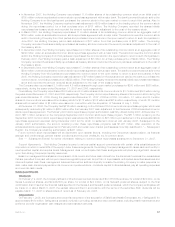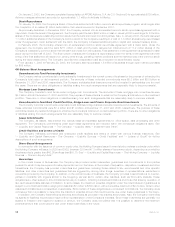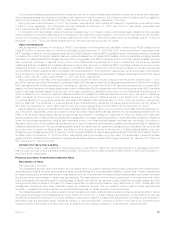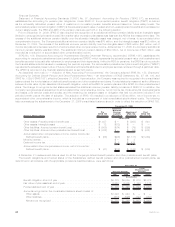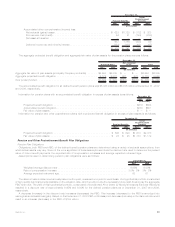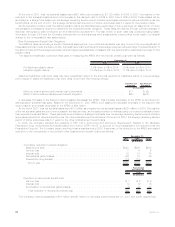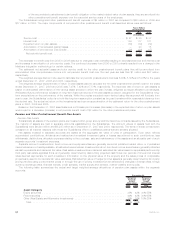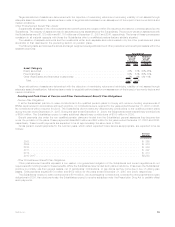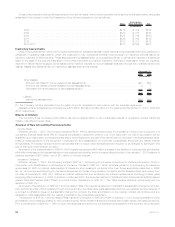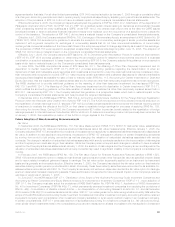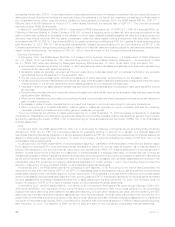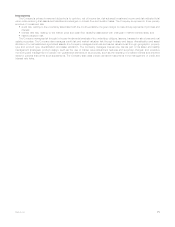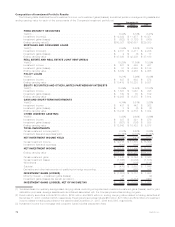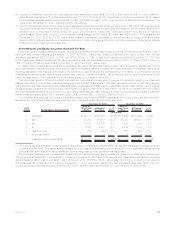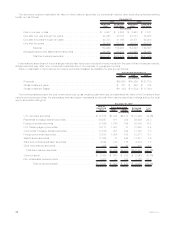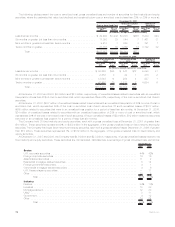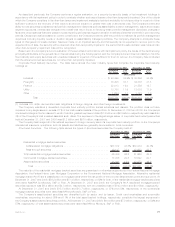MetLife 2007 Annual Report Download - page 71
Download and view the complete annual report
Please find page 71 of the 2007 MetLife annual report below. You can navigate through the pages in the report by either clicking on the pages listed below, or by using the keyword search tool below to find specific information within the annual report.of SOP 05-1, DAC on such contracts is to be amortized over the rate reset period. The impact as of January 1, 2007 was a cumulative
effect adjustment of $292 million, net of income tax of $161 million, which was recorded as a reduction to retained earnings.
Defined Benefit and Other Postretirement Plans
Effective December 31, 2006, the Company adopted SFAS 158. The pronouncement revises financial reporting standards for defined
benefit pension and other postretirement plans by requiring the:
(i) recognition in the statement of financial position of the funded status of defined benefit plans measured as the difference
between the fair value of plan assets and the benefit obligation, which is the projected benefit obligation for pension plans
and the accumulated postretirement benefit obligation for other postretirement plans;
(ii) recognition as an adjustment to accumulated other comprehensive income (loss), net of income tax, those amounts of
actuarial gains and losses, prior service costs and credits, and net asset or obligation at transition that have not yet been
included in net periodic benefit costs as of the end of the year of adoption;
(iii) recognition of subsequent changes in funded status as a component of other comprehensive income;
(iv) measurement of benefit plan assets and obligations as of the date of the statement of financial position; and
(v) disclosure of additional information about the effects on the employer’s statement of financial position.
The adoption of SFAS 158 resulted in a reduction of $744 million, net of income tax, to accumulated other comprehensive income,
which is included as a component of total consolidated stockholders’ equity. As the Company’s measurement date for its pension and
other postretirement benefit plans is already December 31 there was no impact of adoption due to changes in measurement date. See also
“Summary of Critical Accounting Estimates.”
Stock Compensation Plans
As described previously, effective January 1, 2006, the Company adopted SFAS 123(r) including supplemental application guidance
issued by the SEC in Staff Accounting Bulletin (“SAB”) No. 107, Share-Based Payment (“SAB 107”) — using the modified prospective
transition method. In accordance with the modified prospective transition method, results for prior periods have not been restated.
SFAS 123(r) requires that the cost of all stock-based transactions be measured at fair value and recognized over the period during which a
grantee is required to provide goods or services in exchange for the award. The Company had previously adopted the fair value method of
accounting for stock-based awards as prescribed by SFAS No. 123, Accounting for Stock-Based Compensation (“SFAS 123”) on a
prospective basis effective January 1, 2003, and prior to January 1, 2003, accounted for its stock-based awards to employees under the
intrinsic value method prescribed by APB 25. The Company did not modify the substantive terms of any existing awards prior to adoption of
SFAS 123(r).
Under the modified prospective transition method, compensation expense recognized during the year ended December 31, 2006
includes: (a) compensation expense for all stock-based awards granted prior to, but not yet vested as of January 1, 2006, based on the
grant date fair value estimated in accordance with the original provisions of SFAS 123, and (b) compensation expense for all stock-based
awards granted beginning January 1, 2006, based on the grant date fair value estimated in accordance with the provisions of SFAS 123(r).
The adoption of SFAS 123(r) did not have a significant impact on the Company’s financial position or results of operations as all stock-
based awards accounted for under the intrinsic value method prescribed by APB 25 had vested prior to the adoption date and the
Company had adopted the fair value recognition provisions of SFAS 123 on January 1, 2003.
SFAS 123 allowed forfeitures of stock-based awards to be recognized as a reduction of compensation expense in the period in which
the forfeiture occurred. Upon adoption of SFAS 123(r), the Company changed its policy and now incorporates an estimate of future
forfeitures into the determination of compensation expense when recognizing expense over the requisite service period. The impact of this
change in accounting policy was not significant to the Company’s financial position or results of operations as of the date of adoption.
Additionally, for awards granted after adoption, the Company changed its policy from recognizing expense for stock-based awards over
the requisite service period to recognizing such expense over the shorter of the requisite service period or the period to attainment of
retirement-eligibility.
Prior to the adoption of SFAS 123(r), the Company presented tax benefits of deductions resulting from the exercise of stock options
within operating cash flows in the consolidated statements of cash flows. SFAS 123(r) requires tax benefits resulting from tax deductions in
excess of the compensation cost recognized for those options be classified and reported as a financing cash inflow upon adoption of
SFAS 123(r).
Derivative Financial Instruments
The Company has adopted guidance relating to derivative financial instruments as follows:
• Effective January 1, 2006, the Company adopted prospectively SFAS No. 155, Accounting for Certain Hybrid Instruments
(“SFAS 155”). SFAS 155 amends SFAS No. 133, Accounting for Derivative Instruments and Hedging (“SFAS 133”) and SFAS No. 140,
Accounting for Transfers and Servicing of Financial Assets and Extinguishments of Liabilities (“SFAS 140”). SFAS 155 allows financial
instruments that have embedded derivatives to be accounted for as a whole, eliminating the need to bifurcate the derivative from its
host, if the holder elects to account for the whole instrument on a fair value basis. In addition, among other changes, SFAS 155:
(i) clarifies which interest-only strips and principal-only strips are not subject to the requirements of SFAS 133;
(ii) establishes a requirement to evaluate interests in securitized financial assets to identify interests that are freestanding
derivatives or that are hybrid financial instruments that contain an embedded derivative requiring bifurcation;
(iii) clarifies that concentrations of credit risk in the form of subordination are not embedded derivatives; and
(iv) amends SFAS 140 to eliminate the prohibition on a qualifying special-purpose entity (“QSPE”) from holding a derivative financial
instrument that pertains to a beneficial interest other than another derivative financial interest.
The adoption of SFAS 155 did not have a material impact on the Company’s consolidated financial statements.
• Effective October 1, 2006, the Company adopted SFAS 133 Implementation Issue No. B40, Embedded Derivatives: Application of
Paragraph 13(b) to Securitized Interests in Prepayable Financial Assets (“Issue B40”). Issue B40 clarifies that a securitized interest in
prepayable financial assets is not subject to the conditions in paragraph 13(b) of SFAS 133, if it meets both of the following criteria:
(i) the right to accelerate the settlement if the securitized interest cannot be controlled by the investor; and (ii) the securitized interest
67MetLife, Inc.


